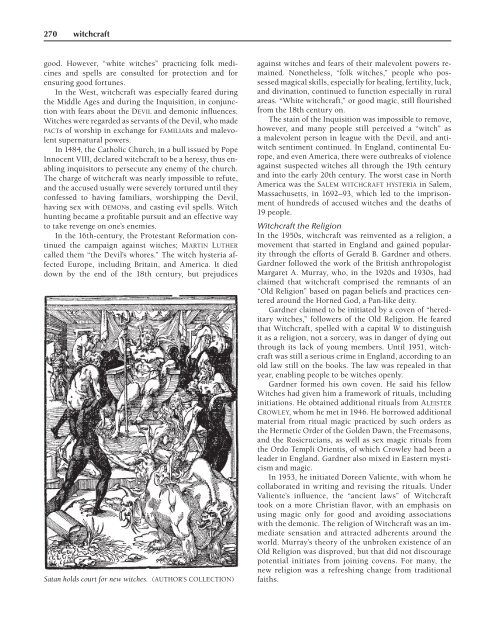The Encyclopedia Of Demons And Demonology
The Encyclopedia Of Demons And Demonology
The Encyclopedia Of Demons And Demonology
You also want an ePaper? Increase the reach of your titles
YUMPU automatically turns print PDFs into web optimized ePapers that Google loves.
270 witchcraft<br />
good. However, “white witches” practicing folk medicines<br />
and spells are consulted for protection and for<br />
ensuring good fortunes.<br />
In the West, witchcraft was especially feared during<br />
the Middle Ages and during the Inquisition, in conjunction<br />
with fears about the DEVIL and demonic influences.<br />
Witches were regarded as servants of the Devil, who made<br />
PACTs of worship in exchange for FAMILIARs and malevolent<br />
supernatural powers.<br />
In 1484, the Catholic Church, in a bull issued by Pope<br />
Innocent VIII, declared witchcraft to be a heresy, thus enabling<br />
inquisitors to persecute any enemy of the church.<br />
<strong>The</strong> charge of witchcraft was nearly impossible to refute,<br />
and the accused usually were severely tortured until they<br />
confessed to having familiars, worshipping the Devil,<br />
having sex with DEMONs, and casting evil spells. Witch<br />
hunting became a profitable pursuit and an effective way<br />
to take revenge on one’s enemies.<br />
In the 16th-century, the Protestant Reformation continued<br />
the campaign against witches; MARTIN LUTHER<br />
called them “the Devil’s whores.” <strong>The</strong> witch hysteria affected<br />
Europe, including Britain, and America. It died<br />
down by the end of the 18th century, but prejudices<br />
Satan holds court for new witches. (AUTHOR’S COLLECTION)<br />
against witches and fears of their malevolent powers remained.<br />
Nonetheless, “folk witches,” people who possessed<br />
magical skills, especially for healing, fertility, luck,<br />
and divination, continued to function especially in rural<br />
areas. “White witchcraft,” or good magic, still flourished<br />
from the 18th century on.<br />
<strong>The</strong> stain of the Inquisition was impossible to remove,<br />
however, and many people still perceived a “witch” as<br />
a malevolent person in league with the Devil, and antiwitch<br />
sentiment continued. In England, continental Europe,<br />
and even America, there were outbreaks of violence<br />
against suspected witches all through the 19th century<br />
and into the early 20th century. <strong>The</strong> worst case in North<br />
America was the SALEM WITCHCRAFT HYSTERIA in Salem,<br />
Massachusetts, in 1692–93, which led to the imprisonment<br />
of hundreds of accused witches and the deaths of<br />
19 people.<br />
Witchcraft the Religion<br />
In the 1950s, witchcraft was reinvented as a religion, a<br />
movement that started in England and gained popularity<br />
through the efforts of Gerald B. Gardner and others.<br />
Gardner followed the work of the British anthropologist<br />
Margaret A. Murray, who, in the 1920s and 1930s, had<br />
claimed that witchcraft comprised the remnants of an<br />
“Old Religion” based on pagan beliefs and practices centered<br />
around the Horned God, a Pan-like deity.<br />
Gardner claimed to be initiated by a coven of “hereditary<br />
witches,” followers of the Old Religion. He feared<br />
that Witchcraft, spelled with a capital W to distinguish<br />
it as a religion, not a sorcery, was in danger of dying out<br />
through its lack of young members. Until 1951, witchcraft<br />
was still a serious crime in England, according to an<br />
old law still on the books. <strong>The</strong> law was repealed in that<br />
year, enabling people to be witches openly.<br />
Gardner formed his own coven. He said his fellow<br />
Witches had given him a framework of rituals, including<br />
initiations. He obtained additional rituals from ALEISTER<br />
CROWLEY, whom he met in 1946. He borrowed additional<br />
material from ritual magic practiced by such orders as<br />
the Hermetic Order of the Golden Dawn, the Freemasons,<br />
and the Rosicrucians, as well as sex magic rituals from<br />
the Ordo Templi Orientis, of which Crowley had been a<br />
leader in England. Gardner also mixed in Eastern mysticism<br />
and magic.<br />
In 1953, he initiated Doreen Valiente, with whom he<br />
collaborated in writing and revising the rituals. Under<br />
Valiente’s influence, the “ancient laws” of Witchcraft<br />
took on a more Christian flavor, with an emphasis on<br />
using magic only for good and avoiding associations<br />
with the demonic. <strong>The</strong> religion of Witchcraft was an immediate<br />
sensation and attracted adherents around the<br />
world. Murray’s theory of the unbroken existence of an<br />
Old Religion was disproved, but that did not discourage<br />
potential initiates from joining covens. For many, the<br />
new religion was a refreshing change from traditional<br />
faiths.












